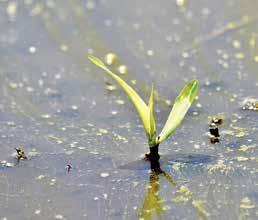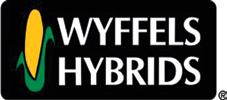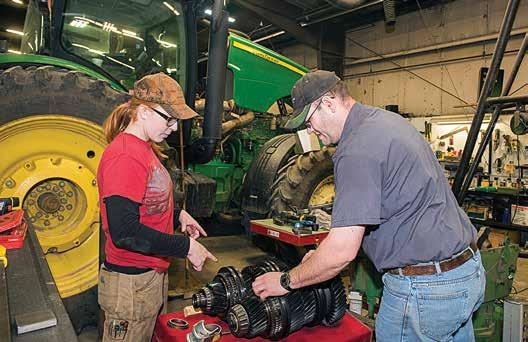
6 minute read
Sow cold, even when it’s so cold
by Shaw Media
Shaw Media file photo During late winter, farmers can broadcast species such as clover or grass over pastures to thicken the stand and improve production.
Jack Frost may nip at farmers’ noses, but he can help take care of their fields, too
Story by Martha Blum AgriNews Publication s/Shaw Media
FREEPORT — Farmers looking to improve their pastures or waterways, or cut down on feed costs can start doing it now, but the window in which to do it won’t be open for long.
During a recent agronomy summit in Freeport, Laura Lant, an agronomist for Midwest Grass & Forage in Macomb, promoted the benefits of frost planting, a method of broadcasting seeds on the surface in late winter or early spring. The process lets nature do most of the work, relying on the freeze-thaw cycle and early showers to improve seed-to-soil contact.
During this time of the year, soil can move up and down, drawing seeds into tiny cracks caused by the cycle, eliminating the need for tilling. But time is of the essence. “We’re only 4 to 5 weeks away from frost seeding time,” said Lant during the Northwest Illinois Agronomy Summit on Jan. 14 in Freeport, an event hosted by University of Illinois Extension.
During late winter, farmers can broadcast species such as clover or grass over pastures to thicken the stand and improve production.
“It is an effective way to increase the pasture, whether you want to keep it in pasture for 3 to 4 years or you just need it to tide you by for a few months or until fall,” Lant said.
Continued on page 17
PERU WALTHAM SERVING YOUR HOME & FARM INSURANCE NEEDS SINCE 1878
FrankMcConville McConville InsuranceAgency Mendota&Tonica, IL815-539-9714 815-442-3116
Cherish Kellett Dimond Bros Insurance Spring Valley, IL 815-663-9905 Bart Hartauer Hartauer Insurance Agency LaSalle, IL 815-223-1795
Mike Gonet HartauerInsuranceAgency Granville, IL 815-339-2411
Right Product. Right Acre. Right People.


Pioneer brand products, service, Pioneer Premium Seed Treatment and PROBulk® System
Michael Michlig ( 815 ) 878-4430 Justin Peterson ( 815 ) 878-3496 SHEFFIELD, ILLINOIS MJ Seed Agency
Some forage species work better than others for frost seeding.
“Clovers are the most common and probably the most economical,” Lant said.
“Adding a legume will produce nitrogen, so that is very beneficial for yields and fertility of any grasses out there,” she said. “If you need something for one year, consider annual ryegrass, Italian ryegrass, Frosty clover or some of the red clovers.”
After the 2019 growing season, where many farmers planted forages on prevent plant acres or for emergency hay needs, Lant said there may be limited supplies of some seeds.
“Make sure you’re planning ahead for those sooner rather than later,” she said. With little snow cover this year, Lant said, farmers have an opportunity to do some scouting of their pastures and hay fields.
“If you were questioning some hay fields last year, do some scouting and then revise your plan of what you’re going to need this year,” she said.
“Knowing that hay prices have gotten high at auctions, in central Illinois we’ve got some guys who aren’t livestock producers who plan to put in a hay field or two to capitalize on that market.” Lant encourages farmers to plant improved genetics when reseeding or renovating pastures.
“All too often I see guys go cheap and skimp on pastures species,” she said. “They’re using products like Kentucky 31 that were developed in the 1930s and ‘40s and I don’t think anyone here would plant a corn hybrid or soybean variety from 2010 let alone something 50 or 60 years old.”
A lot of innovations have occurred in forage seed production.
“You may have to spend $10 to $15 more per acre, but see if that makes sense for your operation” Lant said.
“Along with improving your systems and higher yield, you may find things like red clover with less hair that’s going to dry down quicker for dry hay or you may find a fescue that has a soft leaf and more palatable,” she said.
There are options for livestock producers who think they may be short on feed early in the spring.
“Fortunately, we’ve been able to have cows on stalks in a lot of places to help prevent this,” Lant said. “If you did get cover crops in, grazing Triticale, cereal rye or annual ryegrass in the spring is a great option to keep feed costs down.” Another option is to plant something in late February to early March, such as a forage oat or forage pea.
“That can be accomplished for $25 to $30 per acre and can really help to tide you over until you get to the summer annuals,” Lant said.
“Last year, we sold a lot of summer annuals to folks who had never tried them before because of prevent plant and that really depleted the seed supply,” she said. “Teff seed produced in 2019 was planted in 2019, so there will be some seed shortages this year.”
Therefore, Lant said, it is important for farmers to plan ahead and work with their seed suppliers early.
Continued from page 15
Government aid and insurance payments helped lessen the impact of low crop production last year, but they do not fix the problem.
“There is a legitimate concern here,” Doherty said, as to the ability of some farmers to make debt payments on capital investments like machinery and land improvements.
“That percentage of farmers is going to be a higher percentage than it was last year at this time,” he said. “We are poorly poised to deal with that.”
Adapting to a wetter future
“There are strategies that can be taken to adapt to a wetter spring,” Ford said, including soil conservation, field treatments and improving drainage. Meier said farmers may adapt by planting earlier, managing fields differently or using strains of crops that respond better to wet fields.
“You learn to start planning,” he said, adding that proactiveness helped him through periods of drought in the 1980s. Constantly adapting to worsening weather conditions, though, might not work in the long term, especially since crop production is what brings in a farm’s income.
“Agriculture, especially here in the middle of the Grain Belt, is a volume business,” Doherty said. “You cannot make money off bushels you don’t grow or that you don’t have.”
Being at the mercy of Mother Nature, he said, will always be part of the job.
“This is the nature of farming. You can’t control the weather.”

Shaw Media file photo The state’s climatologist is predicting Illinois farmers are likely to endure more burdensomely wet weather while they try to plant cash crops this spring after suffering major losses as a result of a record-wet planting season last year.
Peterson Bros.
James Peterson

Seed Representative
13344 US Hwy 6 Geneseo, IL 61243 ph. 800-369-7833 www.wyffels.com
400 South West St Wyanet, IL 61379 cell: 815-878-1269 jamespete64@gmail.com
GrowingtoServeToday’sFarmer

MANLIUS 101 1st St. PO Box 347 815.445.2311 SHEFFIELD 15132 Il Hwy. 40 815.454.2352 BRADFORD Il Hwy. 40 309.897.7491 CAMBRIDGE 13429 Il Hwy. 81 PO Box 182 309.937.2435








